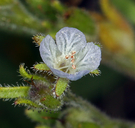Taxon Report
Phacelia leonis J.T. HowellSiskiyou phacelia |
 ©2019 Steve Matson |
Taxon Summary
Phacelia leonis, commonly known as Siskiyou phacelia, is a annual herb in the Hydrophyllaceae that is found in California and elsewhere. It occurs within Meadows and seeps, and Upper montane coniferous forest (openings), growing at elevations from 1200 to 2000 meters. Phacelia leonis is ranked 1B.3, Plants Rare, Threatened or Endangered in California and Elsewhere; Not very threatened in California.Classification
|
Scientific Name: |
Phacelia leonis J.T. Howell |
|
Common Name: |
Siskiyou phacelia |
| Family: | Hydrophyllaceae |
| Element Code: | PDHYD0C2N0 |
| USDA Plants Symbol: | PHLE2 |
|
Synonyms/Other Names: |
|
Ecology and Life History
| Lifeform: | annual herb |
| Blooming Period: Jun-Aug | Jun-Aug |
| Elevation: | 1200-2000 (3935-6560) |
| General Habitats: | Meadows and seeps, Upper montane coniferous forest |
| Microhabitat: | Serpentine (often) |
| Microhabitat Details: |
Conservation Status
| CA Rare Plant Rank: | 1B.3 |
| Global Rank: | G3 |
|
State Rank: |
S2? |
| State List: | None |
| Fed List: | None |
| Other Status: | BLM_S |
|
CRPR Changes: |
|
Occurrence Data from the CNDDB
| Total Occurrences: | 24 |
| Element Occurrence Ranks: | |
| Excellent (A) | 1 |
| Good (B) | 6 |
| Fair (C) | 0 |
| Poor (D) | 0 |
| None (X) | 0 |
| Unknown (U) | 17 |
| California Endemic: False | |
| California Counties and Islands: Name (Code) | |
| Del Norte (DNT), Siskiyou (SIS), Trinity (TRI) | |
| Quads: Name (Quad Code) | |
| Takilma (4212315), Billys Peak (4112227), Caribou Lake (4112218), Cecil Lake (4112312), Chimney Rock (4112356), Covington Mill (4012287), Dees Peak (4112313), Mount Eddy (4112234), Mumbo Basin (4112225), Polar Bear Mtn. (4112385), Scott Mountain (4112236), Seven Lakes Basin (4112224), Smoky Creek (4012332), Tangle Blue Lake (4112226), Whisky Bill Peak (4112215), Ycatapom Peak (4112217) | |
Threat List Data from the CNDDB
| Threat List Total: | 6 | |
| EOs with Threat Listed: | Total EOs | % of EOs |
| 6 | 25 % | |
| Grazing | 5 | 20% |
| Foot traffic/trampling | 2 | 8% |
| Logging | 1 | 4% |
| ORV activity | 1 | 4% |
| Other | 1 | 4% |
| Recreational use (non-ORV) | 1 | 4% |
Selected References
| Phacelia leonis account for potential Species of Conservation Concern evaluation (2021) |
Citation
California Native Plant Society, Rare Plant Program. 2025. Rare Plant Inventory (online edition, v9.5.1). Website https://www.rareplants.cnps.org [accessed 24 December 2025].